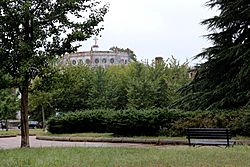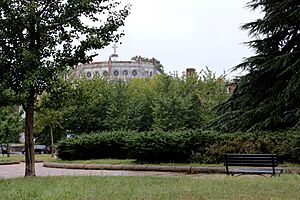Grant Circle facts for kids
Quick facts for kids Grant Circle |
|
|---|---|

Grant Circle, with Petworth United Methodist Church in the background, in September 2016.
|
|
| Location | |
| Washington, DC | |
| Roads at junction: |
New Hampshire Avenue NW Illinois Avenue NW Varnum Street NW 5th Street NW |
| Construction | |
| Type: | Traffic circle |
| Maintained by: | DDOT |
| Map | |
| Lua error in Module:Infobox_road/map at line 15: attempt to index field 'wikibase' (a nil value). | |
| Grant Circle Park | |
|---|---|
| Lua error in Module:Location_map at line 420: attempt to index field 'wikibase' (a nil value). | |
| Location | Formed by the intersection of Massachusetts Ave., Illinois Ave, Varnum St., & 5th St. NW; triangle bound by Illinois Ave., 5th St., & Webster St. NW; and triangle bound by Illinois Ave., 5th St., & Webster St. NW Washington, D.C. |
| Area | 1.8 acres (7,300 m2) |
| Operated by | National Park Service Rock Creek Park |
Grant Circle is a special traffic circle in the Petworth neighborhood of Northwest Washington, D.C.. It is a place where several streets meet, like New Hampshire and Illinois Avenues NW, Varnum Street NW, and 5th Street NW.
Inside the circle, there is a park. This park and the small green areas next to it are managed by the National Park Service. They are part of the Rock Creek Park system. In 2015, Grant Circle and the buildings around it were added to the National Register of Historic Places. This means they are important historical sites.
Contents
History of Grant Circle
Grant Circle was first called Sheridan Circle. It was renamed Grant Circle in 1889. The circle is named after Ulysses S. Grant. He was a famous general for the Union Army during the American Civil War. Later, he became the President of the United States two times. A local newspaper called Grant Circular is also named after this circle.
Early Days of the Circle
Around 1895, Grant Circle was not paved. The area around it had many trees. There was not much business there, just an old peanut stand.
By 1920, the blocks around the circle were fully built up. The road around the circle was paved in 1921. It was about 40 feet (12 meters) wide.
Important Buildings Around the Circle
The Petworth Methodist Episcopal Church bought land near Grant Circle. They built a new church there. Their old church had to move because the city needed the land for a school. This school is now Petworth Elementary School. The new church was finished in 1916. It was designed by M.F. Moore.
The Petworth Catholic Church was built on the northwest side of Grant Circle. It was built in 1920.
Street Lighting at Grant Circle
Grant Circle was one of the first places in Washington, D.C., to get special streetlights. These lights are called "Bacon lampposts." They have a unique design. The United States Commission of Fine Arts approved these lights in 1924. Today, you can still see them in the city's historic areas.
Park Features
The park inside Grant Circle is about 1.8 acres (0.73 hectares) big. The National Park Service takes care of it.
What You Can Find in the Park
The park has many different trees and bushes. It offers walkways for people to stroll. There are also park benches where you can sit and relax. The open grassy areas are great for walking dogs.
There are no statues or memorials in the park. At one time, people thought about moving a fountain from the U.S. Botanic Garden to Grant Circle. However, this never happened. When the circle was first built, it was very far from the city center. People thought putting a statue of Ulysses S. Grant there would not be respectful.
Playground Area
To the north of the main circle, there is a small fenced-in playground. This area is perfect for younger visitors to play.


